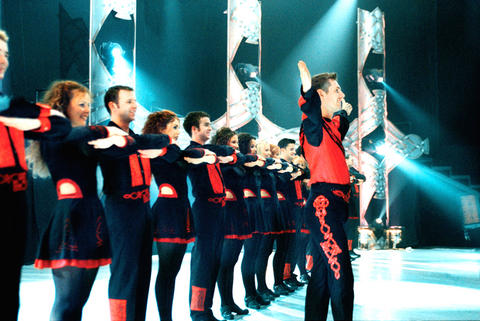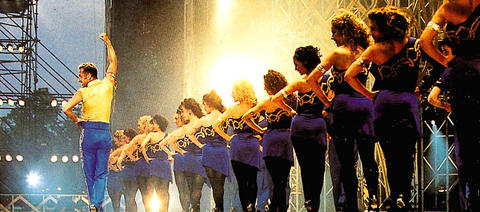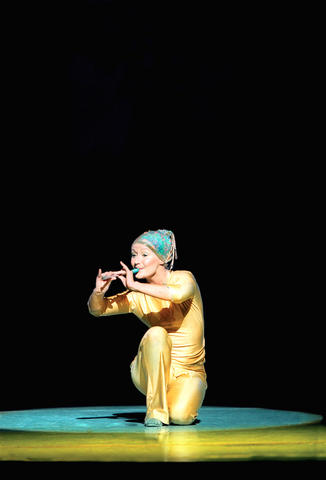Bare chested men in leather pants, women with long tresses and short skirts, lines of dancers stamping in unison - this is the image that Michael Flatley's tap dance extravaganzas evoke. Critics sniff at the shamelessly flashy Vegas-style pageantry and purists are repelled by what is thought to be a bastardized rendering of a once-obscure art form, but millions of fans cheer Flatley's lordly presence. Feet of Flames, recreated for this Taiwan tour nearly 10 years after its legendary premiere in Hyde Park, London, is a dance blockbuster that mixes contemporary choreography, Celtic dance and music with pyrotechnics, explosive visual effects and video displays designed to overwhelm.
Flatley's story is well-known. The son of a Chicago construction contractor who immigrated from Ireland, Flatley was brought up in a house with a solid work ethic and two champion Irish dancers - his mother and grandmother. With an almost manic drive to raise himself up in the world (Flatley once reportedly said that he didn't have time to read anything other than self-help and motivational books) the then-aspiring lad managed to become the first American World Irish Dance Champion at 17. His first big break came when he scored a gig with the Chieftains in the 1980s, which eventually led to an interval act for the 1994 Eurovision Song Contest. The seven-minute prototype of Riverdance performed there was expanded into a full-length production and made Flatley an instant star. Flatley left the production amid a bitter dispute over the copyright of the Riverdance routines and went on to stage The Lord of the Dance in 1996. The rest is history.
Dubbed the turbo-charged reworking of Lord of the Dance, Feet of Flames was created in 1998, following the same storyline but doubling the number of dancers and adding new music, numbers, sets and costumes. The dance spectacle is representative of Flatley's updated and popularized version of traditional Irish step dancing.

PHOTO: COURTESY OF KHAM
Credited to Irish parish priests who developed the dance style due to concerns about lascivious bodily display, step dancing involves a stiff torso and rigidly held arms juxtaposed against quick, precise movements of the feet. In the skillful hands of Flatley, the staid dance was turned into a showbiz spectacular glazed with full-on sexuality and expressive choreography.
For those who aren't familiar with the story, Feet of Flames recounts the perennial tale of the battle between good and evil, represented by the Lord of the Dance and Don Dorcha, the Dark Lord. A lusty romance sub-plot spices things up with Irishwoman Colleen Saoirse winning the heart of the Lord of the Dance from the wicked temptress Morrigan.
Flatley himself will not dance in the Taiwan shows, and the lead role will be played by Damien O'Kane, who played Flatley's original role when Lord of the Dance visited Taiwan in 2004.

PHOTO: COURTESY OF KHAM
According to Yang Yu-tsun (楊玉存) of Kuang Hong Arts (寬宏藝術), restaging Feet of Flames in Taiwan after its world tour ended seven years ago was made possible by the almost insatiable thirst that Taiwanese audiences have for Flatley's shows. Lord of the Dance, which was staged here in 2004 and 2005, and Celtic Tiger a year later, all proved enormously successful.
"When Flatley came with Celtic Tiger in 2006, we suggested the possibility of bringing Feet of Flames to Taiwan since so many people love his shows," Yang said. "After six months of communications and persuasion, Flatley finally agreed to re-stage the production in Taiwan."
The two-hour show has cost over NT$100 million to stage in Taiwan, and every effort has been made to match the grand scale of the original London production. Nearly 100 dancers will sashay, prance and leap on the multi-tiered stage against displays of pyrotechnics and rear-screen projections. Around 20 crew members have been flow in from the UK to construct the set with the aid of local theater technicians. The troupe has been rehearsing intensively in Kaohsiung for the last two weeks, but requests for interviews were rejected.

PHOTO: COURTESY OF KHAM
Performances in Taipei and Taichung are nearly sold out. Tickets for the Kaohsiung and Tainan shows are selling quickly. Flatley may have taken his last curtain call as the Lord of the Dance, but the show he created and continues to direct still works box office magic.

PHOTO: COURTESY OF KHAM

In the March 9 edition of the Taipei Times a piece by Ninon Godefroy ran with the headine “The quiet, gentle rhythm of Taiwan.” It started with the line “Taiwan is a small, humble place. There is no Eiffel Tower, no pyramids — no singular attraction that draws the world’s attention.” I laughed out loud at that. This was out of no disrespect for the author or the piece, which made some interesting analogies and good points about how both Din Tai Fung’s and Taiwan Semiconductor Manufacturing Co’s (TSMC, 台積電) meticulous attention to detail and quality are not quite up to

April 21 to April 27 Hsieh Er’s (謝娥) political fortunes were rising fast after she got out of jail and joined the Chinese Nationalist Party (KMT) in December 1945. Not only did she hold key positions in various committees, she was elected the only woman on the Taipei City Council and headed to Nanjing in 1946 as the sole Taiwanese female representative to the National Constituent Assembly. With the support of first lady Soong May-ling (宋美齡), she started the Taipei Women’s Association and Taiwan Provincial Women’s Association, where she

Chinese Nationalist Party (KMT) Chairman Eric Chu (朱立倫) hatched a bold plan to charge forward and seize the initiative when he held a protest in front of the Taipei City Prosecutors’ Office. Though risky, because illegal, its success would help tackle at least six problems facing both himself and the KMT. What he did not see coming was Taipei Mayor Chiang Wan-an (將萬安) tripping him up out of the gate. In spite of Chu being the most consequential and successful KMT chairman since the early 2010s — arguably saving the party from financial ruin and restoring its electoral viability —

It is one of the more remarkable facts of Taiwan history that it was never occupied or claimed by any of the numerous kingdoms of southern China — Han or otherwise — that lay just across the water from it. None of their brilliant ministers ever discovered that Taiwan was a “core interest” of the state whose annexation was “inevitable.” As Paul Kua notes in an excellent monograph laying out how the Portuguese gave Taiwan the name “Formosa,” the first Europeans to express an interest in occupying Taiwan were the Spanish. Tonio Andrade in his seminal work, How Taiwan Became Chinese,